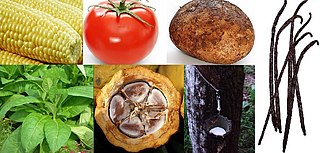
This list of historical cuisines lists cuisines from recent and ancient history by continent. Current cuisine is the subject of other articles.

This list of historical cuisines lists cuisines from recent and ancient history by continent. Current cuisine is the subject of other articles.




A cuisine is a style of cooking characterized by distinctive ingredients, techniques and dishes, and usually associated with a specific culture or geographic region. Regional food preparation techniques, customs, and ingredients combine to enable dishes unique to a region.

Chop suey is a dish from American Chinese cuisine and other forms of overseas Chinese cuisine, generally consisting of meat and eggs, cooked quickly with vegetables such as bean sprouts, cabbage, and celery, and bound in a starch-thickened sauce. It is typically served with rice, but can become the Chinese-American form of chow mein with the substitution of stir-fried noodles for rice.
African cuisine is a staple of the continent's culture, and its history is entwined with the story of the native people of Africa. The foods that native Africans eat have been influenced by their religions, as well as by their climates and lifestyles. The first Africans to inhabit the continent were hunter-gatherers who ate what they could find in nature. As agriculture became more common in Africa, so did agriculture-based diets.

Indigenous cuisine of the Americas includes all cuisines and food practices of the Indigenous peoples of the Americas. Contemporary Native peoples retain a varied culture of traditional foods, along with the addition of some post-contact foods that have become customary and even iconic of present-day Indigenous American social gatherings. Foods like cornbread, turkey, cranberry, blueberry, hominy, and mush have been adopted into the cuisine of the broader United States population from Native American cultures.

The following outline is provided as an overview of and topical guide to the preparation of food:

New World crops are those crops, food and otherwise, that are native to the New World and were not found in the Old World before 1492 AD. Many of these crops are now grown around the world and have often become an integral part of the cuisine of various cultures in the Old World. Notable among them are the "Three Sisters": maize, winter squash, and climbing beans.
South Indian cuisine includes the cuisines of the five southern states of India—Tamil Nadu, Andhra Pradesh, Karnataka, Kerala and Telangana—and the union territories of Lakshadweep, and Pondicherry. There are typically vegetarian and non-vegetarian dishes for all five states. Additionally, all regions have typical main dishes, snacks, light meals, desserts, and drinks that are well known in their respective region.

Most of the food items which define modern North Indian and Subcontinental cooking have origins inside the Indian subcontinent though many foods that are now a part of them are based on fruits and vegetables that originated outside the Indian subcontinent.
The global cuisine or world cuisine is a cuisine that is practiced around the world. A cuisine is a characteristic style of cooking practices and traditions, often associated with a specific region, country or culture. To become a global cuisine, a local, regional or national cuisine must spread around the world, its food served worldwide. There have been significant improvements and advances during the 20th century in food preservation, storage, shipping and production, and today many countries, cities and regions have access to their traditional cuisines and many other global cuisines.
The following outline is provided as an overview of and topical guide to cuisines: